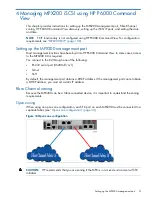
lossless Ethernet network, utilizing DCB switches. Within a 10-GbE based data center, consider
implementing the FCoE protocol.
General IP-SAN
For best results, follow these IP-SAN recommendations:
•
For Microsoft Windows Server environments, implement MPIO along with the HP DSM for
NIC fault tolerance and superior performance.
•
For other operating systems, where supported, implement NIC bonding in the host software
for NIC fault tolerance and performance.
•
Implement a separate subnet or VLAN for the IP storage network for dedicated bandwidth.
•
Implement separate FCoE and iSCSI VLANs.
•
Implement a fault-tolerant switch environment as a separate VLAN through a core switch
infrastructure or multiple redundant switches.
•
Set the individual 1- and 10-Gb ports connected to the storage nodes and servers at auto
negotiate full duplex at both the switch and host/node port level.
•
Implement switches with full-duplex non-blocking mesh backplanes with sufficient port buffer
cache (at least 512 KB per port).
•
Implement Flow Control on the storage network switch infrastructure. Flow control can have
a dramatic impact on performance in a 10 GbE environment, especially in a mixed 1 GbE
and 10 GbE environment. When a network port becomes saturated, excess frames can be
dropped because the port cannot physically handle the amount of traffic it is receiving. Packets
are then resent, resulting in a performance decrease. An example of this is a 10 GbE link
sending data at 10 Gb/s to a single 1 GbE link. Flow control eliminates the problem by
controlling the speed at which data is sent to the port. For this reason, best practices dictate
that you always enable flow control. You must enable flow control on both the switches and
NICs/iSCSI initiators for it to function properly. If flow control is not enabled globally, the
network defaults to the lowest common denominator, which would be to have flow control
disabled.
•
(Optional) Implement Jumbo Frames support on the switch, 1 GbE iSCSI blade, and 10-GbE
iSCSI/FCoE blade when iSCSI is configured, and all servers are connected to the IP-SAN.
Consider using 4–K Jumbo Frames instead of 9–K Jumbo Frames for better streaming
performance.
NOTE:
FCoE requires Jumbo Frames and is the default configuration of a CNA, converged
network switch, and the 10-GbE iSCSI/FCoE blade when FCoE is configured.
Recommended switch infrastructure for an IP-SAN
HP recommends using HPN ProCurve Ethernet switches, which typically include minimum capabilities
for building a high performance fault-tolerant storage network in a relatively easy and cost effective
way. Any Enterprise-class managed switch typically has the necessary capabilities that most IP-SAN
customers require.
Table 5 (page 24)
describes minimum recommended Ethernet switch capabilities
for an MPX200 based IP-SAN.
For more information about FCoE, see the converged network switches and the HP SAN Design
Reference Guide at
http://h18006.www1.hp.com/storage/networking/index.html
.
MPX200 storage and IP network best practices
23
















































